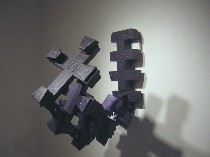 I find myself filled with wonder at the quirkiness of the art world. The latest quirk is an effort by Slought Foundation and blind African-American artist David Stephens to burn 12 small crosses Friday, Dec. 3 at an as yet undisclosed location.
I find myself filled with wonder at the quirkiness of the art world. The latest quirk is an effort by Slought Foundation and blind African-American artist David Stephens to burn 12 small crosses Friday, Dec. 3 at an as yet undisclosed location.
The theory is that such an act will take the sting out of racist cross burnings by co-opting the symbol for non-racist meanings. By burning the crosses, Stephens and Slought state they are exercising free speech as defined in the Supreme Court’s Virginia vs. Black decision, which struck down the state of Virginia’s law banning intimidation aimed at any group via cross burnings.
The theory is lovely.
The fact is not.
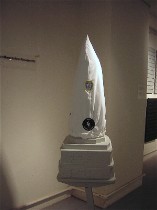 Any person who might feel threatened by a burning cross will feel threatened if they happen upon these burning crosses. We’re talking here about a good portion of the people of Philadelphia. How many of them will know in advance of espying the crosses, that this is the act of a blind, African-American artist who has good intentions? Where’s the advertising campaign to prepare people for this act? I shudder to think of the responses and potential outcomes (my native optimism fails me here).
Any person who might feel threatened by a burning cross will feel threatened if they happen upon these burning crosses. We’re talking here about a good portion of the people of Philadelphia. How many of them will know in advance of espying the crosses, that this is the act of a blind, African-American artist who has good intentions? Where’s the advertising campaign to prepare people for this act? I shudder to think of the responses and potential outcomes (my native optimism fails me here).
Meanwhile, Slought has been blocked at a number of locales, all of which are owned by the University of Pennsylvania. Penn said the burning violates some ordinance or bit of code. For a change, the killer bureaucracy’s endemic caution is on the side of sanity. Stay in touch with Slought if you would like to attend.
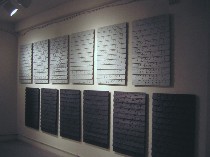 Cross burnings aside, I thought Stephens’ sculptures at Slought have quite a bit of presence, with gigantic Braille dots, a Ku Klux Klan sculpture that made me think of Casper the Friendly Ghost except for the holes in the hood and the Klan patches, and several things that require Cliff Notes (just like most stuff at Slought). The title of the show–“Non-Retinal: Kovert Konflagration Kovenant”– also requires Cliff Notes, or perhaps Kliff Notes.
Cross burnings aside, I thought Stephens’ sculptures at Slought have quite a bit of presence, with gigantic Braille dots, a Ku Klux Klan sculpture that made me think of Casper the Friendly Ghost except for the holes in the hood and the Klan patches, and several things that require Cliff Notes (just like most stuff at Slought). The title of the show–“Non-Retinal: Kovert Konflagration Kovenant”– also requires Cliff Notes, or perhaps Kliff Notes.
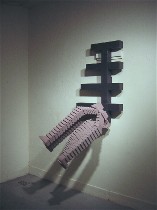
It’s not so much the Koncepts that require Klarification as the allusions. Take the title. Non-retinal refers to Marcel Duchamp’s insistence that he disliked “retinal art,” preferring a conceptual approach. And then take the conversation between Queen Candice, Ebed-melech and Barry and Byron Black. More than a Bible Konkordance is required. All of these references obscure what is otherwise quite straightforward work which does have some retinal as well as tactile presence.
I learned from Aaron Levy that Stephens cuts his wood himself, using a circular saw. Since my own circular saw scares the Bejeezus out of my sighted self, and since I knew a couple of people who lost fingers to circular saws, this fills me with wonder.
Also at Slought are four other bodies of work, all of which require a fair amount of reading and study.
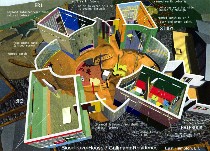 My favorite was “Architecture Against Death,” which includes slides of fabulous (literally) architectural/landscape drawings from Arakawa + Gins (right, a plan for a house). The literature that goes with this work is exhausting, but the visionary nature of the visual part of the work is great fun and made me think of a lot of the stuff we saw recently in the MoMA architecture gallery. I was taken by the beauty of the flights of fancy that may never be realized in the world as we know it. I was not taken by the flight of fancy that somehow this architectural work will put an end to death. Too silly and too horrifying all at once.
My favorite was “Architecture Against Death,” which includes slides of fabulous (literally) architectural/landscape drawings from Arakawa + Gins (right, a plan for a house). The literature that goes with this work is exhausting, but the visionary nature of the visual part of the work is great fun and made me think of a lot of the stuff we saw recently in the MoMA architecture gallery. I was taken by the beauty of the flights of fancy that may never be realized in the world as we know it. I was not taken by the flight of fancy that somehow this architectural work will put an end to death. Too silly and too horrifying all at once.
For Sun Ra fans and folks caught up in Egyptology and their rich Egyptian fantasy life, there’s “Sun Ra Meets Napoleon: Fragments of the Alter-Future.” Included are album art from the estimable Mr. Ra, a concert saluting jazz Philly style, and a screening of a rare film interview of Sun Ra.
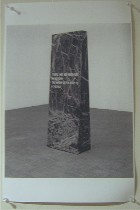 And for those of us who prefer our art off its pedestal, there’s an exhibit of xerox copies of art work, some of it quite amusing, some of it by artists whose names are no longer on our lips but whose work is certainly worth a revisit–even in gray photocopy form (left, Braco Dimitrijevic‘s “Post-Historic Landmark,” inscribed with the words “There are no mistakes in history. The whole of history is a mistake,” got a laugh out of me).
And for those of us who prefer our art off its pedestal, there’s an exhibit of xerox copies of art work, some of it quite amusing, some of it by artists whose names are no longer on our lips but whose work is certainly worth a revisit–even in gray photocopy form (left, Braco Dimitrijevic‘s “Post-Historic Landmark,” inscribed with the words “There are no mistakes in history. The whole of history is a mistake,” got a laugh out of me).
Others in this drag-it-off-the-pedestal show are Luis Benedit, Benni Efrat, Giorgio Griffa, Klaus Rinke and Nachum Tevet. The show, “The Other Epistemology,” is part of what I take to be an on-going effort called “Didacticon: The Museum of Reproductions (at Slought Foundation).” I’m exhausted by all this naming of things, especially with 2 million dollar, academic words; at least this has a touch of dusty humor. Words aside, though, I did enjoy the photocopies because they were of work that was mostly conceptual. And, after all is said and done, Cliff notes and dictionary gripes aside, I’ll stand with Marcel Duchamp and his interest in concepts–just so long as there’s something to look at as well.









